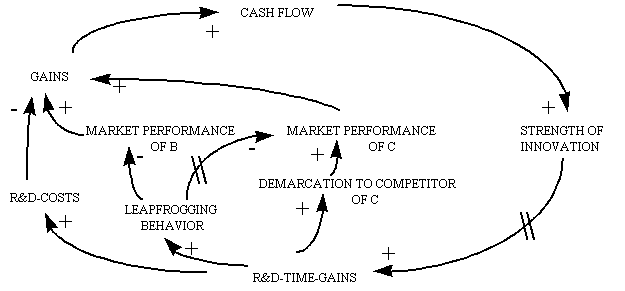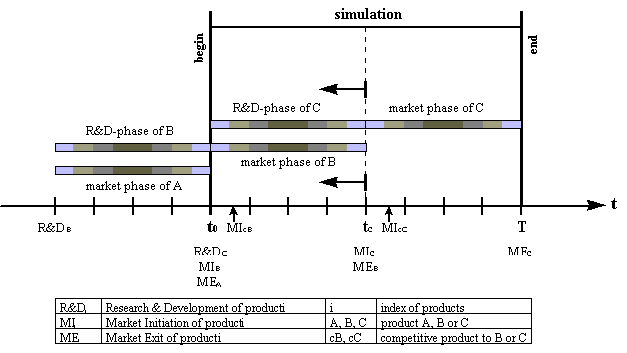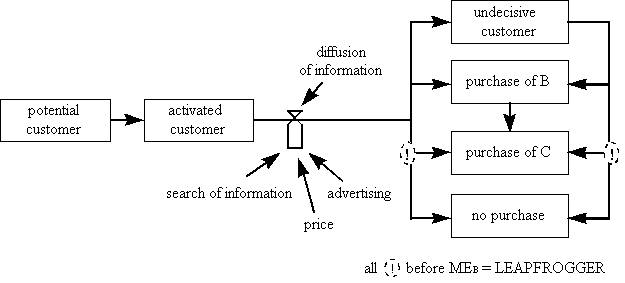
Nowadays the technological progress and the abridgement of innovation cycles lead to a situation in which the risks and opportunity costs of waiting for the next product generation become calculable and relevant for the bargaining decision. The decision to wait causes a cannibalism process between the current and the future product and is called the leapfrogging behavior.
Existing models typically concentrate on the buy-or-wait decisions
of the potential customers (distinguished into innovators, distribution
agents, and adoptors) and present an ex-post distribution of the
decision results. This model focuses on the dynamic market interactions
and their economic impacts on the gain and loss situation of the
observed company.
The competitive situation determines the fungibility of a product in its product life cycle. The main factors of influence are the price and the speed of market penetration.
During the last few decades an additional factor has gained in importance. The customer´s entitlement on product performance and product quality increases continuously. This leads to the situation in which every market initiation of a new product generation starts an „internal ticker" decreasing its market fitness.
Companies react to this restriction of time, which is similar to the biological clock, in the same way nature does. They reproduce their products generation by generation, in specifications which fit to the changing market conditions (customer requirements). Of course their market initiation suits to the current competitive situation (selection). In a competitive market this process implicates the so-called „innovation war". The main weapon of the contenders is to reach the market faster and faster with the following product generation.
To keep your position in this war, it is necessary to retain your strength of innovation or even improve it. The model (see fig. 1) illustrates the corresponding interactions.

Figure 1: Causal Loop Diagram of Leapfrogging Effects
If the company is able to shorten the R&D phase, the effects are generally positive up to a certain point. This critical point is reached when the market initiation of the following product (MIC) is earlier than the market exit of the current product (MIB). Compare to figure 2.
The earlier the product C emerges, the stronger the cannibalism effects between B and C become. In addition, the company faces an extreme growth in its R&D costs.

Figure 2: The Time Scheme

Figure 3: The Bargaining Decision Process
3. The Analysis and significant Results
Looking at the cannibalism effects in more detail, you can distinguish between two different aspects. On the one hand, the impact on the distribution of product B is negative. On the other hand, potential customer base available to product C has been reduced artificially by the time MEB is reached. Both aspects reduce the opportunity of achieving additional revenue through the time advantage gained over competitors.
It can be proved that from a certain point of time onwards, the
negative factors outweigh the benefits. Apart from the effects
of a longer market phase of product C, the reduction of its R&D
phase has a negative effect. A shorter R&D phase causes distortions
in the early phases of information diffusion which impact particularly
on the multiplicator function of the innovators and distribution
agents.
Bloomfield, R., and R. Libby. 1996. Market Reactions to Differentially Available Information to the Laboratory. Journal of Accounting Research 34(2): 183-207.
Dosi, G., R. Gianetti, and P.A. Toninelli. 1992. Technology and Enterprise in a Historical Perspective. Oxford: Clarendon.
Kotzbauer, N. 1992. Erfolgsfaktoren neuer Produkte: der Einfluß der Innovationshöhe auf den Erfolg technischer Produkte. PhD-Thesis. University of Regensburg.
Kroeber-Riel, W. 1996. Konsumentenverhalten. München: Vahlen.
Lizardo de Araujo, J. 1995. Are Technology Diffusion Processes Inherently Historical? Technological Forecasting and Social Change 48: 243-257.
Meyer, M.H., and J.M. Utterback. 1993. The Product Family and the Dynamics of Core Capability. Sloan Management Review 34(3): 29-47.
Milling, P. 1986. Diffusionstheorie und Innovationsmanagement. In Technologie und Innovations-management, ed. E. Zahn. Berlin: Duncker and Humblot.
Mohapatra, P.K.J., and B.K. Saha. 1996. A System-Dynamics-Based Game for New Product Growth. Simulation and Gaming 27(2): 238-260.
Schmalen, H., F.-M. Binninger, and H. Pechtl. 1993. Diffusionsmodelle als Entscheidungshilfe zur Planung absatzpolitischer Maßnahmen bei Neuprodukteinführungen - Modelltheoretische Implikationen einer empirischen Untersuchung. Die Betriebswirtschaft 53(4): 513-527.
Von Braun, C.-F. 1994. Der Innovationskrieg. München, Wien: Carl Hanser.
Weiber, R., and A. Pohl. 1994. Leapfrogging bei der Adoption neuer Technologien. Working Paper. Trier: University of Trier.
Weiber, R., and A. Pohl. 1996. Das Phänomen der Nachfrageverschiebung.
Zeitschrift für Betriebswirtschaft 66(6): 675-696.